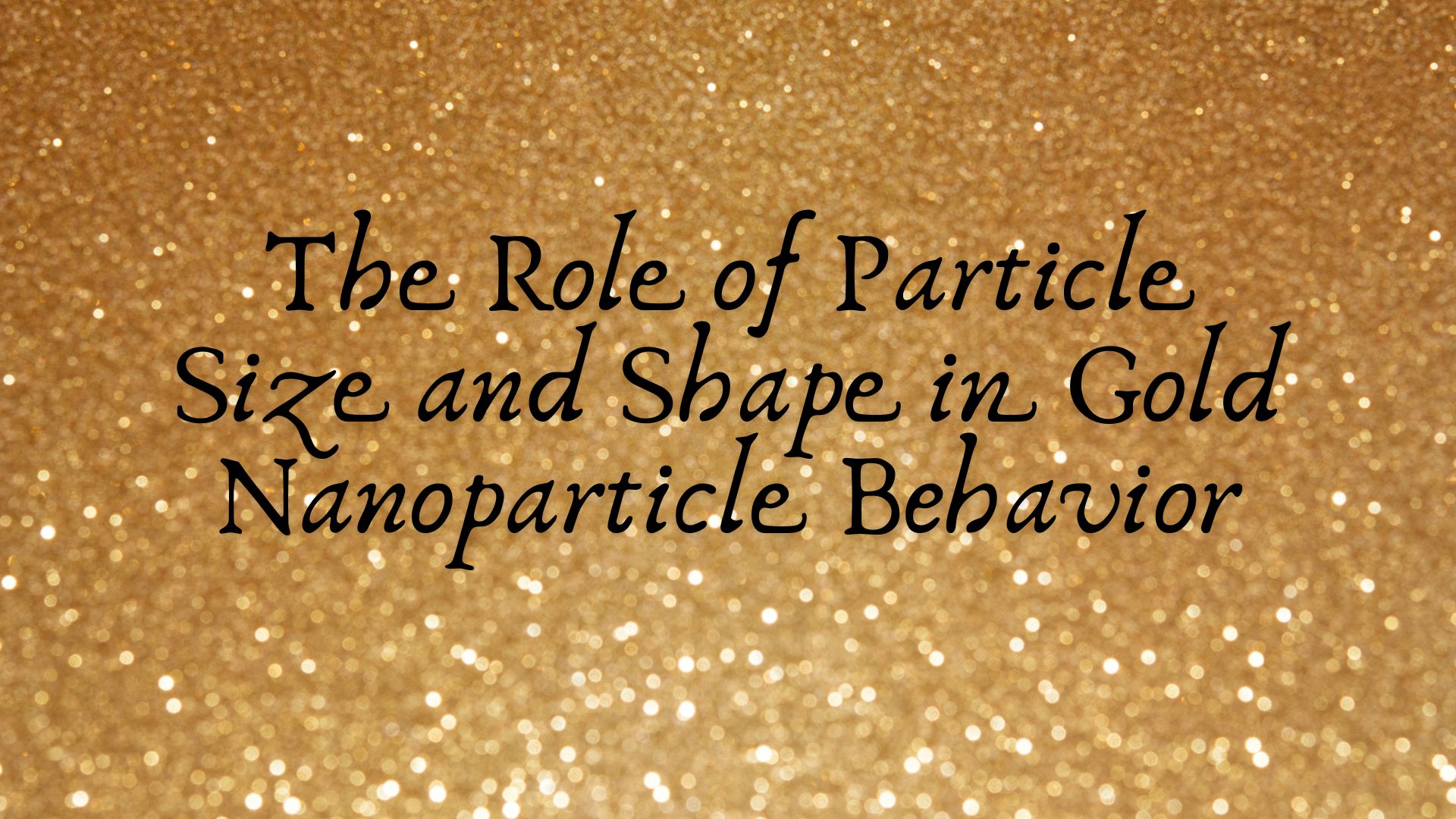Gold nanoparticles (AuNPs) have become one of the most extensively studied nanomaterials in modern science due to their unique optical, chemical, and biological properties. These tiny particles—ranging from a few nanometers to several hundred nanometers—exhibit characteristics that differ significantly from bulk gold. A critical factor determining their behavior is their size and shape. Understanding how these parameters influence the physical, chemical, and biological performance of gold nanoparticles is essential for optimizing their use in various fields such as medicine, catalysis, sensing, and electronics.
Understanding Gold Nanoparticles
Gold nanoparticles are nanoscale colloidal gold particles that can be synthesized in various sizes and morphologies, including spheres, rods, cubes, stars, cages, and shells. Their versatility makes them suitable for applications ranging from targeted drug delivery to photothermal cancer therapy. What makes AuNPs particularly fascinating is that even small variations in their size and shape can drastically alter their optical and electronic properties.
At the nanoscale, gold atoms behave differently due to the quantum confinement effect, surface-to-volume ratio, and plasmonic resonance—factors that depend on how large or small the particle is and how it is geometrically structured.
The Impact of Particle Size
Optical Properties and Surface Plasmon Resonance (SPR)
The most notable size-dependent property of gold nanoparticles is their surface plasmon resonance (SPR)—the collective oscillation of electrons at the nanoparticle’s surface when exposed to light. The SPR wavelength shifts depending on the particle size:
- Smaller nanoparticles (less than 20 nm) tend to absorb light in the blue-green region, giving colloidal solutions a red color.
- Larger nanoparticles (greater than 50 nm) absorb light at longer wavelengths, leading to purple or blue-colored solutions.
This tunability of optical properties based on size is vital for designing nanoparticles for biosensing, imaging, and photothermal applications.
Catalytic Activity
Smaller AuNPs have a higher surface-to-volume ratio, providing more active sites for catalytic reactions. This makes them particularly effective in processes like CO oxidation or selective oxidation of alcohols. However, extremely small nanoparticles (below 2 nm) may lose their metallic properties, which can alter their catalytic efficiency. Therefore, an optimal balance between size and stability is crucial for catalytic performance.
Stability and Aggregation
Particle size influences colloidal stability. Smaller particles, though more reactive, have higher tendencies to aggregate due to strong van der Waals forces. Stabilizing agents or surface modifications are often employed to prevent aggregation and maintain uniform dispersion in solutions.
Biological Interaction and Cellular Uptake
In biomedical applications, the particle size determines biodistribution, cellular uptake, and clearance from the body.
- Nanoparticles in the range of 10–100 nm are most effective for cellular uptake.
- Particles smaller than 10 nm are quickly cleared by renal filtration.
- Larger particles (>100 nm) may be trapped by the reticuloendothelial system (RES).
Thus, selecting the right size is essential for ensuring optimal therapeutic efficacy and minimal toxicity.
The Influence of Particle Shape
Beyond size, the shape of gold nanoparticles plays a significant role in determining their properties and performance. Different morphologies—such as nanorods, nanostars, nanocubes, and nanoshells—exhibit unique electronic structures and surface energies.
Optical Anisotropy
While spherical nanoparticles have a single SPR band, anisotropic shapes such as rods or stars show multiple plasmon resonance modes.
- Gold nanorods, for instance, display two SPR peaks—one for the transverse and another for the longitudinal mode—allowing for tunable absorption in the near-infrared (NIR) region.
- This property is especially useful in biomedical imaging and photothermal therapy, where NIR light can penetrate deeper into biological tissues.
Surface Reactivity
Different crystal facets are exposed on different shapes. For example, cubes primarily expose {100} facets, while octahedra expose {111} facets. These surface orientations affect chemical reactivity, adsorption behavior, and catalytic performance. Researchers can therefore tailor the shape of AuNPs to optimize their reactivity for specific applications.
Interaction with Biomolecules
Shape also governs how nanoparticles interact with biomolecules such as proteins and DNA. Rod-shaped or star-shaped nanoparticles may bind differently to cell membranes compared to spherical ones, influencing uptake efficiency and biological response. For drug delivery or gene therapy, shape optimization ensures enhanced targeting and minimal immune response.
Combined Effects of Size and Shape
While size and shape individually affect nanoparticle behavior, their combined influence often determines overall functionality. For example, small nanorods may offer strong optical absorption in the NIR region but might also be more prone to aggregation than larger spherical nanoparticles. Similarly, triangular or star-shaped AuNPs with sharp tips exhibit enhanced electromagnetic fields (“hot spots”), making them superior for surface-enhanced Raman spectroscopy (SERS) applications.
The challenge lies in achieving precise control over both parameters during synthesis. Techniques such as seed-mediated growth, template-assisted methods, and chemical reduction processes are employed to achieve this level of control.
Applications Influenced by Size and Shape
Biomedical Applications
- Drug Delivery: Size and shape influence circulation time, targeting efficiency, and drug release behavior.
- Imaging and Diagnostics: Spherical and rod-shaped AuNPs are used in CT scans, fluorescence imaging, and Raman spectroscopy.
- Photothermal Therapy: Nanorods and nanoshells with NIR absorption efficiently convert light to heat, enabling localized cancer treatment.
Catalysis
The catalytic activity of AuNPs depends heavily on both their size and exposed facets. Smaller, irregularly shaped nanoparticles tend to be more catalytically active but less stable, while larger or symmetric shapes offer better durability.
Environmental Sensing
In environmental applications, gold nanoparticles are used in sensors for detecting heavy metals or pollutants. Shape-dependent plasmonic responses improve sensitivity and signal-to-noise ratios in these devices.
Challenges and Future Directions
Despite remarkable progress, challenges remain in achieving uniform control over nanoparticle morphology at large scales. Minor inconsistencies in synthesis can lead to variability in behavior, affecting reproducibility. Future research is focusing on developing green synthesis methods and machine learning-based predictive models to design nanoparticles with precise size and shape characteristics for targeted applications.
Moreover, understanding how size and shape affect nanoparticle interactions with biological systems is essential for ensuring safe and ethical use in medicine. Researchers are also exploring hybrid structures—combining gold with other materials—to further enhance functionality.
Conclusion
The size and shape of gold nanoparticles are more than just physical attributes—they define their entire personality in the nanoscale world. From optical properties and catalytic efficiency to biological compatibility, every aspect of gold nanoparticle behavior is shaped by these two critical factors. As synthesis techniques continue to advance, scientists are gaining unprecedented control over the morphology of AuNPs, opening new frontiers in medicine, energy, and nanotechnology.



